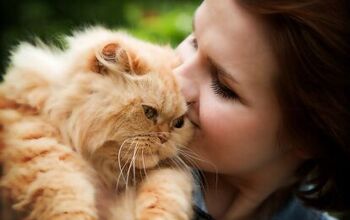What are the Benefits of Silver Vine for Cats?

As loving cat parents, we understand that a happy cat is a cat whose natural instincts are nurtured and whose days are filled with purpose and play. While many of us are familiar with the often hilarious effects of catnip, a staple in many cat households, there’s another natural option to add a little “spice” to your cat’s day: silvervine. This plant offers a unique experience for cats. It may even work for cats who are indifferent to catnip (yes, that does happen).
In this post, I will share precisely what silvervine is, why it works so effectively to entertain our cats, and the many benefits it offers for both their physical and mental well-being. While I’m not saying you need to replace your cat’s go-to favorites (we still have catnip toys in our house), this could be the perfect option to add something new and exciting to their toy lineup!
What Exactly is Silvervine?
To truly appreciate the benefits of silvervine for your cat, it helps to understand what it is and what your cat experiences. Scientifically known as Actinidia polygama, silvervine actually belongs to the Kiwi family! The plant is indigenous to the rugged, mountainous regions of East Asia, where it thrives in the dense forests of Japan, China, Korea, and even parts of Siberia. It grows as a woody vine, often climbing and intertwining with other vegetation throughout its natural habitat.
The silvervine plant features heart-shaped leaves and produces small, kiwi-like fruits that are called “silvervine fruits” or “matatabi fruits.” The plant has a long history of use in human folk remedies among certain Asian cultures. In some instances, the fruit is even consumed (although it’s not as common as the kiwi).
When processing it for our cats to enjoy, there are four common forms:
- Dried Sticks: Resembling a small twig, this is arguably the most popular form. It’s perfect for chewing and batting around. Example: WoLover Silvervine Sticks for Cats
- Powder: Finely ground, this can be sprinkled on toys, scratching posts, or even a small amount on their food. Example: Raw Paws Silvervine Powder
- Sprays: An extract is a great choice for refreshing existing toys or enticing your cat to show interest in new items, such as carriers or beds. Example: JAYU PET 100% Natural Silvervine Spray for Cats
- Leaves: Dried leaves or fruits are sometimes used in sachets or as loose playthings on their own. Example: Meowy Janes Whole Dried Silvervine Gall Fruit
While it’s similar to catnip in many ways, there's a notable chemical difference that allows it to appeal to an even larger number of cats.
Why Cats Love Silvervine
Understanding why silvervine holds such a powerful allure for our cats will require basic knowledge of feline neurobiology. Its spell is all thanks to specific chemical compounds within the plant and the response they trigger.
The Active Compounds
Catnip’s magic lies primarily in a compound called nepetalactone. Silvervine, however, involves a more complex cocktail of substances that trigger a response from our cats. The most significant and potent active compound in the plant is nepetalactol. But it also contains other compounds that are intriguing to your cat, like actinidine and dihydroactinidiolide.
How it Works
When a cat inhales or ingests silvervine, these compounds (particularly nepetalactol) interact with your cat’s brain. This interaction triggers a natural release of endorphins, aka the body’s “feel-good” chemicals. This flood of endorphins is what leads to feelings of pleasure or euphoria. This is what causes them to act like they are “high” after being exposed to it.
The most interesting aspect of this reaction is that silvervine appears to engage different receptors in the brain than catnip. For this reason, it may impact cats who show no response to catnip. Studies show that only approximately two-thirds of adult cats actively respond to catnip. Meanwhile, approximately 80% of cats react to silvervine. Your cat may be genetically predisposed to responding to one but not the other, or to both.
Typical Cat Reactions to Silvervine
When a cat encounters silvervine, their reactions can be pretty varied. For some, it will trigger feelings of excitement and playfulness. For others, it can help them chill and relax. But generally, most reactions fall into a predictable set of behaviors:
- Affection: Many cats will begin by rubbing their face and body against the silvervine, soon followed by enthusiastic rolling.
- Oral Stimulation: Licking and drooling are both common sensory responses to the plant.
- Playful Energy: A burst of playful energy often follows, including swatting, pouncing, kicking with hind legs, and sometimes an increase in vocalizations, such as chirps, trills, or purrs.
- Relaxation and Bliss: After the initial burst of activity, some cats enter a calm, relaxed, almost dream-like state. Eventually, they will return to normal energy levels once again.
Each of these responses is entirely normal and a sign that your cat is enjoying the silvervine experience.
The Benefits of Silvervine for Your Cat’s Well-Being
Most cat parents who are interested in silvervine are focused on the fun experience for their cat, but it actually offers a list of benefits that contribute significantly to their health and well-being. From mental enrichment to physical activity, incorporating silvervine into your cat’s daily routine can boost their quality of life.
Mental Enrichment and Stimulation
One of the most significant benefits of introducing silvervine to your cat is its ability to provide much-needed mental enrichment and stimulation, helping you to keep them happy and entertained throughout the day (even when you’re at work). Cats, even those living indoors, have natural predatory instincts and a sharp intelligence that need to be worked and challenged. Imagine being stuck indoors 24/7, surrounded by the same things day in and day out, with nothing to do to entertain yourself.
Silvervine, with its unique scent and effects, creates an exciting experience that can break up their day, introducing a fun and unpredictable element of play. The focused play it encourages promotes mental engagement, allowing your cat to flex their problem-solving skills and stay sharp.
If you have a sensitive or anxious cat, silvervine is also known to have a euphoric and calming effect. Whether they are nervous about an upcoming vet visit, stressed about the move to a new home, or worried about the introduction of a new pet into their household, silvervine can help soothe agitated nerves and promote a more relaxed state of mind.
Physical Activity and Exercise
In today’s day and age, feline obesity is a growing concern. Many (if not all) veterinarians are going out of their way to recommend more physical activity, an important piece in the healthy weight puzzle. However, cat parents aren’t always sure how to go about that. After all, you can’t just tell your cat to exercise more!
Silvervine is a great way to encourage high-energy play, motivating even the most sedentary cat to tap into playful and energetic behavior they may otherwise forgo. It can transform a lounging cat into an active hunter, pouncing, swatting, and kicking as they go after their specially scented prey.
Regular playtime is crucial for:
- Supporting Healthy Weight: Consistent play helps burn calories and maintain a healthy weight, which is an important step in preventing obesity and its associated health complications (like diabetes, arthritis, and heart disease).
- Muscle Toning and Agility: The movements and physical activity involved in silvervine-induced play sessions actively work various muscle groups, improving overall muscle strength, coordination, and agility. It’s like a fun, spontaneous workout session for your cat.
Dental Health Benefits
Few (if any) cats are excited about the idea of having their teeth brushed. However, studies show that somewhere between 50 and 90% of cats older than four are experiencing some form of dental disease. It’s clear we need to do something to protect our best friends!
One of the most practical and often surprising benefits of silvervine, especially in stick form, is the way it can help to improve your cat’s dental health. Cats, much like dogs, have a natural instinct to chew. Silvervine sticks are a positive outlet.
As your cat enthusiastically chews on the fibrous sticks, they will experience the following benefits:
- Plaque and Tartar Removal: The action of chewing helps to physically scrape away plaque and tartar buildup from the surface of your cat’s teeth.
- Gum Stimulation: The chewing motion also gently massages and stimulates your cat’s gums, promoting healthy blood flow and overall gum health.
Training and Behavioral Modification
Whether you’re training your cat to perform tricks, going through the leash training process, or trying to address behavioral problems at home, silvervine’s strong appeal for cats makes it a powerful reward for positive reinforcement. This makes it a high-value motivation for encouraging desired behaviors. For example, you could offer a silvervine-infused toy immediately after your cat uses a new scratching post to reinforce that the post is a positive outlet for this behavior. Or, you could place a silvervine stick or sprinkle a little silvervine into a carrier to help create a positive association, making carrier training less stressful for both of you.
Beyond positive reinforcement, silvervine can help redirect destructive behaviors. If your cat is prone to chewing or scratching furniture or engaging in other undesirable actions, try offering an enticing silvervine toy to redirect their attention. Not only is this a more appropriate outlet for these instincts, but you’ll also enjoy all the other benefits on this list.
Improving the Human-Cat Bond
Finally, and perhaps the most heartwarming benefit, is the opportunity to deepen the bond you share with your cat. One of the best ways to do this is to engage in shared positive experiences, creating a stronger emotional connection. You can do this by playing together with a silvervine toy. Observing your cat’s happiness, playful antics, and contented purrs as they interact with their new toy is incredibly rewarding. The mutual happiness this creates enriches both of your lives.
Tips for Introducing and Using Silvervine Safely
Introducing silvervine to your cat can be exciting, but your cat’s safety is priority #1. Here are a few simple guidelines to help you get started:
Start Slowly
When first offering anything new, including silvervine, it’s always best to start with a small amount or a single toy. Observe your cat’s reaction carefully. Every cat is an individual, and while most respond positively, it’s important not to overwhelm them in the beginning. By introducing it gradually, you allow them to get used to the new scent and the sensation it creates at their own pace.
Different Forms and Their Best Uses
As we have already discussed, silvervine can be purchased in many different forms. Each has its pros and cons to consider, offering unique ways to entertain your cat. Here are some tips to help you decide which form is the best fit:
- Sticks/Chew Toys: These are great for satisfying a cat’s natural urge to chew, making them excellent for dental health and providing a longer-lasting play session.
- Powder: This form is incredibly versatile. You can sprinkle it directly onto existing toys to make them exciting once again, rub it into scratching posts to encourage use, or even offer a tiny pinch on your cat’s food for an internal, calming effect (though always in very small amounts).
- Sprays: Another great option for renewing interest in your cat’s existing toys. Sprays are also good for enticing your cat to investigate new items like a cozy new bed or a travel carrier.
- Leaves/Dried Fruit: These can be placed in fabric sachets for sensory play or offered loose for curious cats to bat around and explore.
Storage
To maintain the potency and freshness of your silvervine, it must be stored properly. Keep it in an airtight container in a cool, dark place, away from direct sunlight or humidity. This will help to preserve the active compounds, ensuring it remains appealing to your cat for longer.
Safety Considerations
A few important points to ensure your cat’s playtime is safe and enjoyable:
- Always supervise your cat during play, especially when introducing new toys or if your cat has a tendency to ingest non-food items.
- If silvervine sticks become chewed down to very small pieces, it’s important to dispose of them promptly to eliminate any potential choking hazard. Check your cat’s silvervine sticks regularly.
- While rare, a small percentage of cats might become overly aggressive or agitated when exposed to silvervine. If you notice any concerning behavior, remove the silvervine or silvervine-treated toys. If the behavior continues, contact your veterinarian.
Join the PetGuide community. Get the latest pet news and product recommendations by subscribing to our newsletter here.

Britt Kascjak is a proud pet mom, sharing her heart (and her home) with her “pack” which includes her husband John, their 2 dogs – Lucifer and Willow – and their 3 cats – Pippen, Jinx, and Theia. She has been active in the animal rescue community for over 15 years, volunteering, fostering and advocating for organizations across Canada and the US. In her free time, she enjoys traveling around the country camping, hiking, and canoeing with her pets.
More by Britt
























